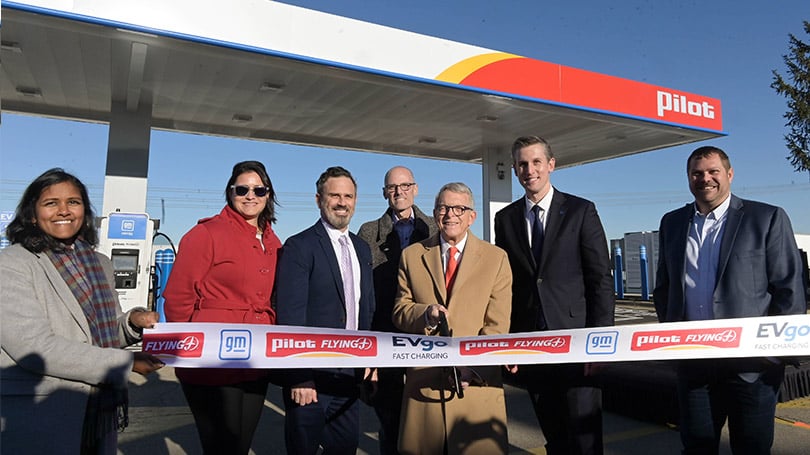Ohio Opens First Infrastructure Bill (NEVI) EV Charging Station, Powered By EVgo
The first NEVI-funded EV charging station opened this week in Ohio to great nationwide celebration among electric vehicle (EV) advocates. At the same time, concern among the EV Industry community focused on the length of time it took to achieve this goal. It’s been two years, and most states are still somewhere in the process of installing their NEVI-funded stations. The White House released a blog this week, giving the latest NEVI updates.

What is NEVI?
The $5 billion National Electric Vehicle Infrastructure (NEVI) Formula Program is part of the $1.2 trillion Infrastructure Investment and Jobs Act (IIJA) signed into law by President Biden in November 2021. NEVI was launched by The U.S. Department of Transportation’s Federal Highway Administration (FHWA). It is a significant initiative aimed at bolstering the EV infrastructure across the nation. This program allocated funds to states for the strategic installation of EV charging stations and to establish a connected network for reliable data collection and access. The funds will cover up to 80% of eligible project costs, including the acquisition, installation, and network connection of EV charging stations. Furthermore, it will also take into account the operation and maintenance of these stations and the long-term data sharing from the charging stations.
The EV charging stations to be installed under this program must be non-proprietary and allow open-access payment methods. They should be publicly available or accessible to authorized commercial motor vehicle operators from multiple companies. These stations will primarily be located along the designated FHWA Alternative Fuel Corridors (AFCs).
The FHWA committed to distributing the NEVI Program funds each fiscal year until FY 2026. Each state will receive an amount equal to the state FHWA funding formula as determined by 23 U.S. Code 104.
Government Funding Is Usually Slow
Government processes are typically characterized by a slow pace, necessitating patience and persistence. Legislations such as the Infrastructure Law pass through numerous stages before they become fully operational. For instance, in the case of the Infrastructure Law, a new joint office had to be established between the Department of Transportation (DOT) and the Department of Energy (DOE). This joint office was tasked with devising rules based on the law’s provisions. Following this, states were invited to formulate plans for creating charging networks. The plans were guided by the requirement to install at least four charging stations, each with a minimum power output of 150 kW, along major highways. Furthermore, the gap between these stations was mandated to be no more than 50 miles, barring certain exceptions.
These plans were then required to gain approval from the joint office before being sent back to respective states for implementation. States then proceeded to solicit vendor proposals, select suitable sites, approve bids, and allocate necessary funding. Following this, the extensive process of station construction and securing utilities to provide power commenced. Now, two years later, most states are still navigating through this process. However, the pace of progress varied significantly among states. Ohio outpaced all, having recently activated the first station under the Infrastructure Law’s NEVI program, leading the charge in this initiative.
Evgo Station Located at the Pilot Travel Center, Madison County, West of Columbus, Ohio
Located at the Pilot Travel Center along Interstate 70 at U.S. Route 42 in Madison County, west of Columbus, you will find this newest charging station. It’s equipped with state-of-the-art fast chargers installed by EVgo. These chargers are designed to provide an impressive output of up to 350 kW when charging a single vehicle, ensuring quick and efficient charging. However, when four vehicles are charging simultaneously, each charging port is capable of delivering up to 175 kW. This station, along with its cutting-edge technology, truly represents a step forward in the expanding infrastructure of electric vehicle charging in the state.
“Any industry that focuses on innovations for the future is a priority for Ohio,” said Governor DeWine. “Electric vehicles are the future of transportation, and we want drivers in Ohio to have access to this technology today.”
Ohio took the lead as the first state in the nation to issue a request for charging station proposals last year. This strategic move positioned Ohio ahead of other states in acquiring sought-after equipment and specialized technicians to install these stations. Demonstrating an ongoing commitment to providing Ohioans with an advantage in the transition to electric vehicles, Ohio became the first state to announce the future sites of its initial round of EV charging stations. Then, in October, Ohio won another first by breaking ground on these EV charging stations.
Construction is set to commence imminently on an additional two dozen fast charging stations across the state, bolstered by funding from NEVI. As part of the first installation round, all chargers are projected to be fully operational by the close of 2024. Much like other states, Ohio will continue to expand the network of stations in the years to follow. The initial focus will be directed towards interstate highways before moving on to other U.S. highways and state routes deemed essential by the federal government through the National Highway System. This strategic approach ensures a systematic rollout of charging stations to facilitate easy access and convenience for EV drivers across the state and nation.
“For years, our team has trailblazed the expansion of electric vehicle infrastructure, becoming a model for other states implementing the NEVI program,” said ODOT Director Jack Marchbanks. “America’s first new charging station puts us one step closer to making travel easier for EV drivers.”
